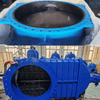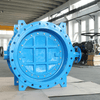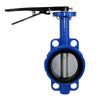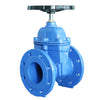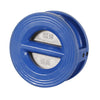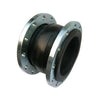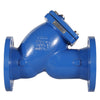Which is better for a globe valve: low inlet, high outlet or high inlet, low outlet?
A globe valve is a common type of valve, ideal for use in shutting off, regulating, and throttling flow. Since the valve stem's travel during opening or closing is relatively short, and it has a very reliable shut-off function, plus the valve seat opening changes in direct proportion to the valve disc travel, it's especially suitable for flow regulation.
We know that globe valves generally use a low inlet and high outlet design, but why do they adopt this design, and are all globe valves designed this way? This article will provide a detailed explanation.
Why Do Globe Valves Use a Low Inlet and High Outlet Design?
When discussing how a globe valve works, we first need to understand a basic concept: the direction of fluid flow. In most cases, a globe valve is designed to allow fluid to flow in from the bottom and out from the top. This low-inlet, high-outlet design is mainly based on the natural flow characteristics of fluids and the working mechanism of the globe valve.
1.Natural flow characteristics: Without outside force, fluids like water or gas tend to flow from areas of lower pressure to higher pressure. The low-inlet, high-outlet design uses this, letting the fluid flow in from the lower pressure inlet and out through the higher pressure outlet.
2.Operating mechanism: The globe valve works by the interaction between the valve stem and the sealing ring. The low-inlet, high-outlet design allows pressure to build up above the sealing ring, helping to seal better and stop fluid leaks.

Globe valve flow diagram
The globe valve uses a low inlet and high outlet design based on the natural flow of the fluid. The main purpose is to reduce flow resistance and make it easier to open. When the valve is closed, the gasket between the valve body and bonnet, and the packing around the valve stem, are not under pressure. This prevents long-term exposure to the fluid's pressure and temperature, helping to extend the valve’s service life and reduce leakage. This design also allows for easier maintenance, such as replacing or adding packing when the valve is closed.
In What Situations Is A Globe Valve High-Inlet And Low-Outlet?
Many people think that all globe valves are low-inlet, high-outlet, but that’s not always the case. In general, globe valves are low-inlet, high-outlet, but there are some special situations where they are high-inlet, low-outlet:
1.High-pressure globe valves with a diameter greater than 100mm
Due to the poor sealing performance of large-diameter valves, this setup allows the medium's pressure to act on the top of the valve disc when the valve is closed, improving the sealing of the valve.
2.Two globe valves in series on a bypass pipeline, with the second valve requiring "high-inlet, low-outlet"
To ensure the tightness of the valve during a maintenance cycle, frequently operated valves require two globe valves installed in series. For the bypass system, this setup serves the following purposes:
- Balances the pressure before and after the main pipeline valve, making it easier to open and reducing wear on the main valve.
- Allows a small flow to warm the pipe during startup.
- In the main feedwater pipeline, controls the feedwater flow to adjust the boiler pressure increase rate, suitable for boiler pressure testing.
Based on the flow direction of the medium, the bypass globe valves are called the first valve and the second valve. During normal operation, both valves are closed and in direct contact with the medium. To prevent the second valve's packing from being exposed to the medium and high temperature for too long, and to allow the packing to be replaced during operation, the second valve requires installation in the "high-inlet, low-outlet" direction.
3.Boiler exhaust and vent globe valves
Boiler exhaust and vent globe valves are only used during the boiler startup water-filling process, with a low frequency of opening and closing. However, due to poor sealing, they often cause loss of working fluid. To improve sealing performance, some power plants install these valves in a "high-inlet, low-outlet" configuration.
4.Electromagnetic quick-closing valves
The function of an electromagnetic quick-closing valve is to close quickly and immediately cut off the fuel supply.
Its structure is similar to that of a globe valve. However, if the working fluid also enters from the bottom and exits from the top, the force exerted by the fuel on the underside of the valve disc would be large, and the counterweight of the electromagnetic quick-closing valve would be much smaller than this force.
But if the working fluid enters from the top, once the quick-closing valve is activated, the pressure behind the valve drops rapidly, and the fuel pressure on the underside of the valve disc is quickly reduced to zero. At this point, the remaining forces are the force exerted by the fuel on the valve disc and the combined force of the counterweight and the lever.
Summary
In large-diameter and high-pressure conditions, using a low-inlet, high-outlet design can make it difficult to close the valve, and the valve stem, being under constant water pressure, may deform or bend over time, affecting the valve's safety and sealing. In contrast, choosing a high-inlet, low-outlet design allows for a smaller valve stem diameter, which can save costs for both manufacturers and users.
The original design of the globe valve is intended for a low-inlet, high-outlet working mode, which aligns with the natural flow characteristics of the fluid and the operating mechanism. However, in certain special applications, to meet specific requirements, a high-inlet, low-outlet design may be used. This requires a detailed analysis in practical applications, and the design should be selected according to actual needs.
For more information on valves, please contact us. Tianjin Union Valve Co., Ltd. not only offers a wide range of standard valves but also provides custom designs to meet the exact specifications of customers.
Related Article:
- What is Cv? A Guide to Valve Flow Coefficient Explained
- Choosing the Right Valves for Efficient Water Supply Systems




